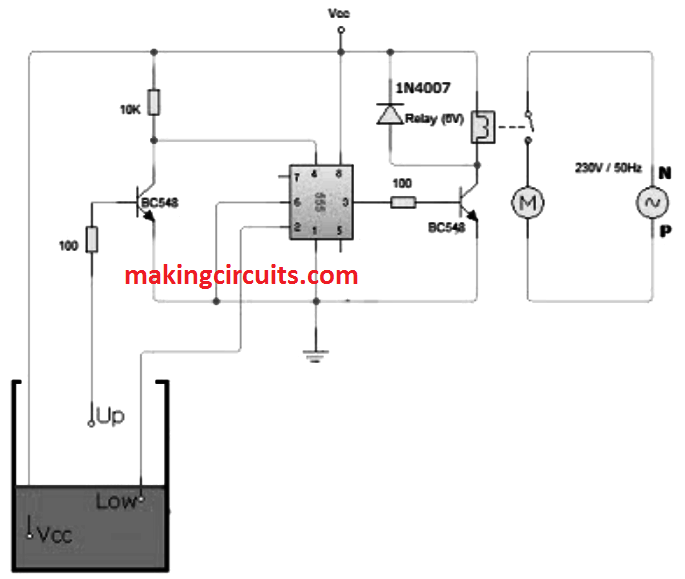The explained IC 555 based Automatic water level control circuit is a straightforward approach, project.
It could automatically switch ON and OFF of the domestic water pump set based on the water level of the tank.
You are able to utilize this motor driver circuit at your home or college employing more affordable components.
The rough cost of the project is around $ 5 only. The principal good thing about this water level controller circuit is that it automatically controls the water pump with no involvement of the consumer.
The control stage of the circuit is an NE 555 IC; here we have manipulated the flip-flop within chip 555.
Our project include two water level sensors, one particular attached at the top and the other towards the bottom.
Functioning of this circuit is practically identical to a stable mutlivibrator Bi.
Working simulation of this circuit is additionally provided below. Undoubtedly this can help you make your academic project.

How this Automatic Water Tank Level Controller Work
-We understand that the property of the chip 555, ie its output will increase once the voltage at the second pin (trigger pin) is no more than 1/3 VDC.
We may also reset the IC by making use of a low voltage to the 4th pinout (reset pins).
In this particular project you will find 3 wires immersed in the water tank. We will specify two levels-Low Water Level (Low) and High (Up) Level. One of the pins of the probe or is of Vcc.
The lower level sensor is hooked up to the trigger (2) of the pin 555 CI. Therefore, the voltage at the 2nd pin is Vcc while it is inside water.
When the water level reduces, the second probe is detached from the water voltage, and the trigger pin gets to be under Vcc. Then the output of 555 gets high.
The output 555 is placed on a BC548 transistor, it triggers the relay coil and also the water pump collectively are switched on.
When the water level goes up, the upper level probe is included in water and the transistor turns OFF. Its collector voltage is VCE (sat) = 0.2.
The low voltage on the 4th pinout resets the IC. Therefore, the output of 555 turns into 0V. Thus the motor is switched OFF.
For a basic demo of this project, you may use a DC motor directly connected across the output of the 555 and ground rather than relay.
For practical execution, you have to make use of a relay. Relay rating is preferred based on the load (motor). Relay 32 amp is most effective for household purposes.
List of Electronic components:
-Power supply (6v)
-NE chip 555
- Resistors (100Ωx2, 10k)
-Relais (6V, 30A)
-BC 548 transistor x2
-1N4007 Diode
Comments
Excellent ! thanks ! and how is the circuit if you have a tank below to feed the water pump… ?
One tank above and other above !
Thanks, you will need two such circuits to control the pump separately using two relays for the two tanks